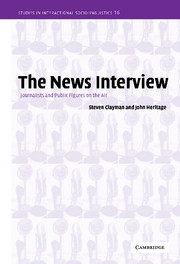Book contents
- Frontmatter
- Contents
- Acknowledgments
- 1 Introduction
- 2 The news interview in context: institutional background and historical development
- 3 Openings and closings
- 4 Basic ground rules: taking turns and “doing” news interview talk
- 5 Defensible questioning: neutralism, credibility, legitimacy
- 6 Adversarial questioning: setting agendas and exerting pressure
- 7 Answers and evasions
- 8 The panel interview: discussion and debate among interviewees
- 9 Conclusion
- Appendix: transcript symbols
- References
- Subject index
- Index of names
5 - Defensible questioning: neutralism, credibility, legitimacy
Published online by Cambridge University Press: 23 November 2009
- Frontmatter
- Contents
- Acknowledgments
- 1 Introduction
- 2 The news interview in context: institutional background and historical development
- 3 Openings and closings
- 4 Basic ground rules: taking turns and “doing” news interview talk
- 5 Defensible questioning: neutralism, credibility, legitimacy
- 6 Adversarial questioning: setting agendas and exerting pressure
- 7 Answers and evasions
- 8 The panel interview: discussion and debate among interviewees
- 9 Conclusion
- Appendix: transcript symbols
- References
- Subject index
- Index of names
Summary
Interviewing can be a hazardous occupation for the professional journalist. Interviewers are closely scrutinized for their conduct toward prestigious public figures, and it is not uncommon for them to become the target of criticism. As noted in chapter 1, Dan Rather's contentious encounter with presidential candidate George Bush ignited a firestorm of protest from various quarters, and even though both parties contributed to the conflictual encounter that resulted (Clayman and Whalen 1988/89), Rather bore the brunt of criticism. A fellow journalist expressed the views of many when he said that Rather “stepped over the line of what is just intelligent professionalism” by moving “outside the role of reporter and … into the role of judge.” A hostile reaction also befell David Frost after his adversarial interview with Emil Savundra, a businessman who had liquidated his auto insurance company leaving many claims outstanding. This interview, which preceded Savundra's trial for fraud, was criticized for its prejudicial impact on the trial, and the appeal judge later commented that such “trial by television is not to be tolerated in a civilized society” (Tracey 1977).
As members of the journalistic profession, news interviewers are expected to adhere to certain basic standards of professional conduct. Most importantly, they are obliged to be objective in their work. As noted in chapters 2 and 4, objectivity is an umbrella concept that encompasses a range of journalistic values, including factual accuracy, balance between opposing views, and neutrality in presentation.
- Type
- Chapter
- Information
- The News InterviewJournalists and Public Figures on the Air, pp. 150 - 187Publisher: Cambridge University PressPrint publication year: 2002

